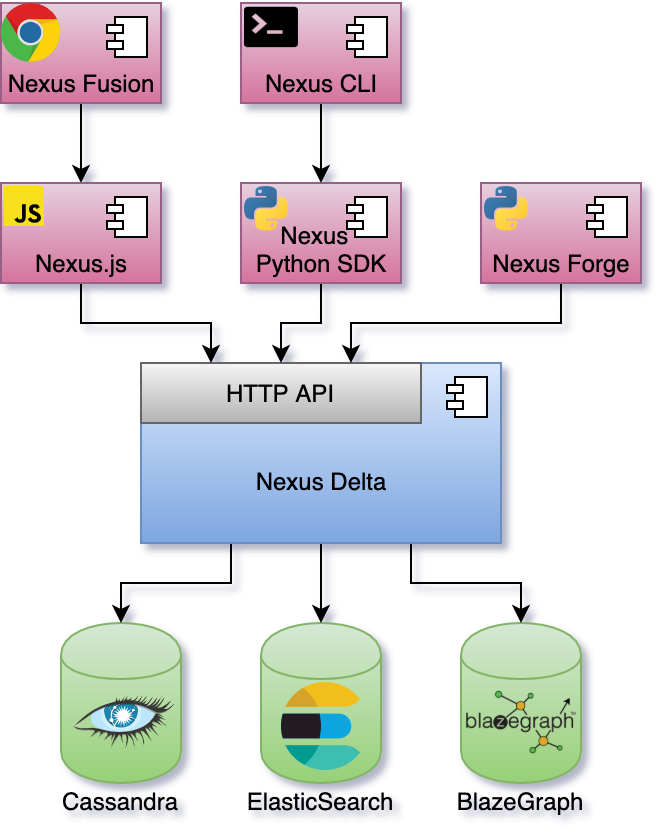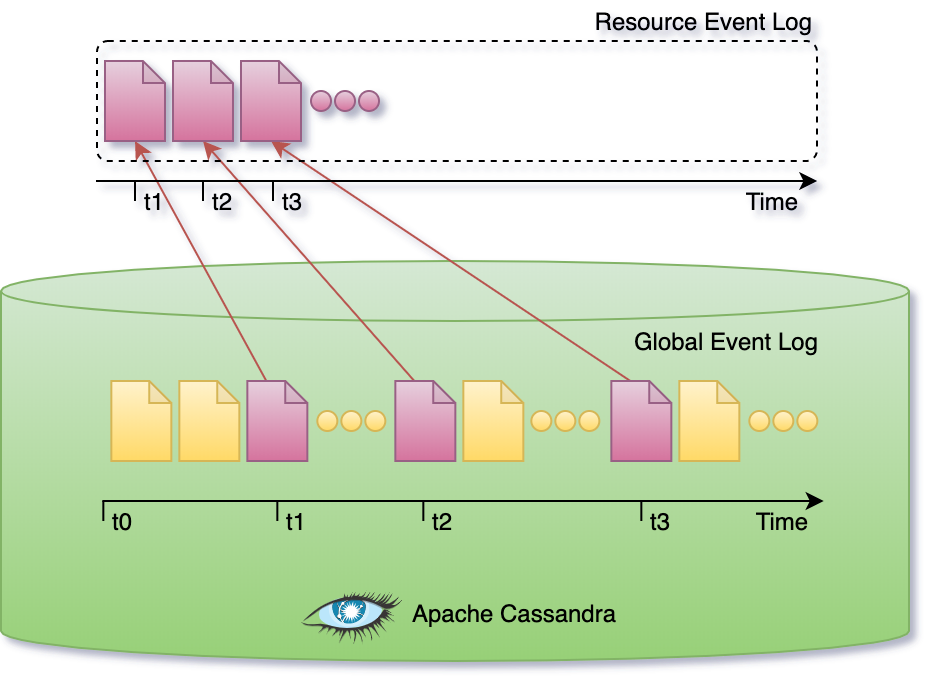You are browsing the docs for Nexus v1.7.x, the latest release is available here
Architecture
Blue Brain Nexus is a collection of software components that address various organizational needs relating to data storage, management, analysis and consumption. It was designed to support the data-driven science iterative cycle at Blue Brain but its genericity allows for its use in arbitrary contexts.
This document focuses on the characteristics of the Nexus Delta and its design choices.
Ecosystem
Nexus Delta is a low latency, scalable and secure service that realizes a range of functions to support data management and knowledge graph lifecycles. It uses Apache Cassandra as a primary store (source of truth for all the information in the system), ElasticSearch for full text search and BlazeGraph for graph based data access.
An overview of the Blue Brain Nexus ecosystem is presented in the figure below:

Nexus Fusion is a web interface that helps scientists with their day-to-day data-driven activities but also facilitates the system administrative tasks. It uses the Nexus.js (a javascript SDK) that provides as set of primitives for building web applications for Nexus Delta.
Nexus Forge is a domain-agnostic, generic and extensible Python framework that enables non-expert users to create and manage knowledge graphs using the Python programming language.
Clustering
One of the more important design goals for the system was to be able scale in order to support arbitrary increases in usage and data volume. Nexus Delta can be configured to run as single node or in a cluster configuration where the load on the system is distributed to all members.
Akka Cluster was chosen for a decentralized, fault-tolerant, peer-to-peer based cluster membership. It uses the Gossip Protocol to randomly spread the cluster state. Nodes in the cluster communicate over TCP using Akka Remoting for coordination and distribution of load.

Apache Cassandra and ElasticSearch were chosen for their horizontal scaling characteristics and for favouring availability over globally strong consistency.
BlazeGraph was initially chosen to handle graph access patterns, but it is currently the only part of the system that cannot be scaled horizontally. We’re currently looking for open source alternatives that offer clustering out of the box or solutions that would coordinate multiple BlazeGraph nodes.
Anatomy
Nexus Delta was built following the Command Query Responsibility Segregation (CQRS) pattern where there’s a clear separation between the read and write models. Intent to change the application state is represented by commands that are validated for access and consistency before being evaluated. Successful evaluations of commands emit events that are persisted to the global event log.
Asynchronous processes (projections) replay the event log and process the information for efficient consumption. The information in the recorded events is transformed into documents (in the case of ElasticSearch) and named graphs (in the case of BlazeGraph) and persisted in the respective stores. The projections persist their progress such that they can be resumed in case of a crash.
Sources of events for projections are both the primary store and other (remote) Nexus Delta deployments through the Server Sent Events W3C recommendation. This allows for data aggregation when building indices.
Native interfaces are offered as part of the read (query) model for querying ElasticSearch and BlazeGraph.

Asynchronous indexing (projections) and the separation between reads and writes have some interesting consequences:
- the system is eventually consistent and does not require a healing mechanism for handling synchronization errors
- the primary store acts as a bulkhead in case of arbitrary data ingestion spikes
- the primary store and the stores used for indices can be independently sized; indexing speed is allowed to vary based on the performance of each store
- the system continues to function with partial degradation instead of becoming unavailable if a store suffers downtime
Apache Cassandra is used as an eventsourced primary store and represents the source of truth for all the information in the system. Updates are not performed in place, state changes are appended to the event log. The state of the system is derived from the sequence of events in the log.
The global event log is partitioned such that there’s no need to replay the entire log. Subsets can be replayed, like for example when reconstructing the current state of a single resource.

Resource Orientation
Nexus Delta is built following the REpresentational State Transfer (REST) architectural style where its functions are consumed via access and manipulation of resources. All information in the system (system configuration or user data) is represented as resources. The API Reference describes all supported resource types, the addressing scheme and available operations.
The subset of events that correspond to single resource represent the resource lifecycle as depicted in the figure below. A resource lifecycle is a series of state transitions, each generating a unique revision.

User data is represented as sub-resources to projects which in turn are sub-resources of organizations. Organization and project resources provide logical grouping and isolation allowing for variation in configuration and access control policies.

Resource identification is based on HTTP Internationalized Resource Identifiers (IRIs) and uniqueness is guaranteed within the scope of a project. This allows the system to be used in a multi-tenant configuration but at the same time it implies that project and organization identifiers are part of a resource addressing scheme.
In order to avoid limitations in URL lengths and for convenience, resource identifiers can be aliased and compacted (CURIE) using project level configurations.
Authentication and Authorization
The system supports OpenID Connect, OAuth 2.0 and JSON Web Tokens (JWTs) standards and can be configured to use identity providers that support these standards. Proof of identity can be provided by passing a Bearer JWT in the Authorization header of the HTTP requests when consuming the RESTful API.
Nexus Delta can use LDAP as an identity management system through several off-the-shelf products that implement these protocols on top of LDAP, like for example Keycloak.
The authorization flow is as follows:
- the provided JWT is validated against the configured identity providers
- the subject and group claims are used to generate the set of identities of the caller (when no Bearer JWT is provided, the assumed identity is Anonymous)
- access to perform the intent is verified by comparing the collection of caller identities with the configured list of ACLs for the target resource(s)